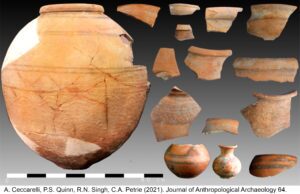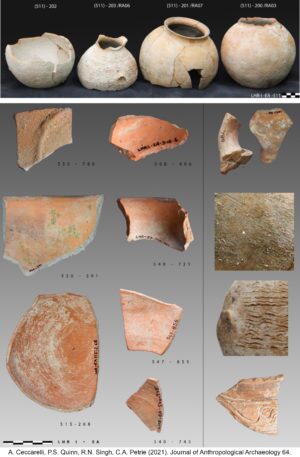
University of Cambridge—A new study of 5,000-year old pottery has revealed how villages of the Indus Civilization developed sophisticated industries during the Bronze Age.
University of Cambridge researchers studied a range of ancient everyday pottery vessels – including jars, bowls, dishes and bottles – to reconstruct how Indus peoples developed and adopted unique technologies in the third millennium BC.
The objects were excavated from archaeological sites in Haryana in north-west India by a team of researchers from the TwoRains project, which is a collaboration between the University of Cambridge and Banaras Hindu University funded by the ERC.
The study, published in the Journal of Anthropological Archaeology, was carried out as part of PhD research by Dr Alessandro Ceccarelli, who is an Affiliated Scholar at the McDonald Institute for Archaeological Research, Cambridge.
Dr Ceccarelli used reverse engineering to reconstruct two main dominant technological traditions in Indus Civilization north-west India. These traditions reveal several forming, fashioning and finishing techniques in making pottery, including the use of types of “potter’s wheel” in some cases.
“This study doesn’t just look at how pottery was made – it gives a fascinating insight into some of the earliest ‘social networks’ and how people passed on knowledge and skills over centuries without the use of books or the technology we now take for granted,” Dr Ceccarelli said.
“The objects we examined suggested that while communities of ceramic makers lived in the same regions – and often in the same settlements – different traditions emerged and were sustained over centuries. There was a clear effort to keep alive their unique ways of making pottery to set them apart from other communities, like a statement of their identity.”
The evidence – shown in the materials and tools used to make the pottery, as well as markings on them – suggests that at these two ancient settlements, at least two distinct groups of Indus ceramic producers passed down unique values, skills and knowledge over generations.
Village-based pottery production also survived the widespread urbanization of the Indus Civilization in the third millennium BC, with household production of ceramics continuing to be the norm in the region for hundreds of years.
Dr Ceccarelli noted: “We also discovered that there is no clear evidence at the excavated sites for making pottery using ‘wheel-throwing’ techniques in the production of these ceramics. This offers a different perspective from the interpretations given to the vast majority of similar types of Indus ceramic forming techniques in the past.”
Senior author Dr Cameron Petrie, University of Cambridge, concluded that “This paper makes an important contribution to the work of the TwoRains project as it highlights the diversity and variability of practices in ancient South Asia, which is something that we feel made populations well suited to coping with variable and changing environmental conditions”
___________________________

Above and below: Examples of pottery samples analyzed. TwoRains Project, University of Cambridge, and Dr Alessandro Ceccarelli.
___________________________

___________________________
Article Source: University of Cambridge news release.
The research is published open access in Journal of Archaeological Science.
A. Ceccarelli, P.S. Quinn, R.N. Singh, C.A. Petrie (2021). Setting the wheels in motion: Re-examining ceramic forming techniques in Indus Civilization villages in northwest India,
Journal of Anthropological Archaeology 64. DOI: https://doi.org/10.1016/j.jaa.2021.101346
This research was funded by the European Research Council (ERC) Consolidator Grant (2015–2021) under the Horizon 2020 research and innovation programme [TwoRains project: grant agreement number 648609]. It was also supported by smaller grants, such as the NTICVA Awards, Nehru Trust for the Indian Collection at the Victoria and Albert Museum, London and the Fitch Laboratory Awards, British School at Athens, Greece.
* https://www.sciencedirect.com/science/article/pii/S0278416521000799?via%3Dihub
____________________________
Advertisement




